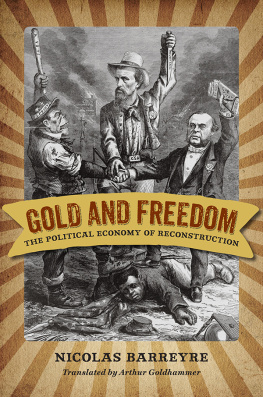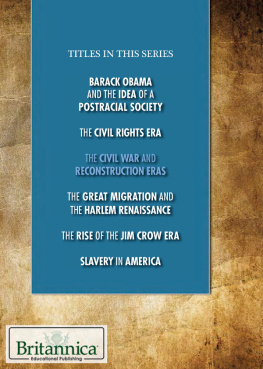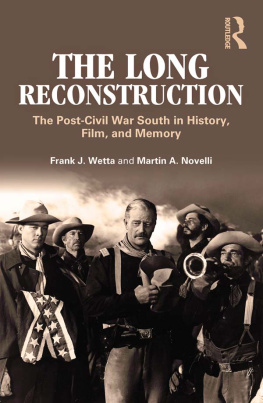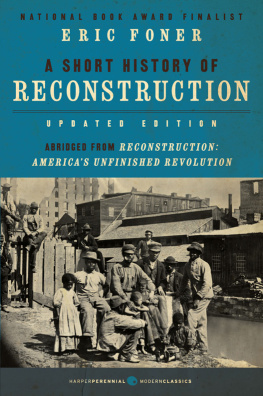University of Virginia Press
2015 by the Rector and Visitors of the University of Virginia
All rights reserved
Printed in the United States of America on acid-free paper
First published 2015
1 3 5 7 9 8 6 4 2
Library of Congress Cataloging-in-Publication Data
Names: Barreyre, Nicolas, 1975
Title: Gold and freedom : the political economy of Reconstruction / Nicolas Barreyre ; translated by Arthur Goldhammer.
Other titles: Or et la libert. English
Description: Charlottesville : University of Virginia Press, 2015.
Includes bibliographical references and index.
Identifiers: LCCN 2015019358 | ISBN 9780813937496 (cloth : acid-free paper)
ISBN 9780813937755 (e-book)
Subjects: LCSH: Reconstruction (U.S. history, 18651877) | Southern
StatesHistory18651877. | United StatesGeographyPolitical
aspectsHistory19th century. | Spatial analysis (Statistics) | United States
Politics and government18651877. | United StatesEconomic
policy. | United StatesHistoryCivil War, 18611865Influence.
Classification: LCCE 668 . B 25513 2015 | DDC 973.8dc23
LC record available at http://lccn.loc.gov/2015019358
Cover art: This is a white mans government,
Thomas Nast, Harpers Weekly, September 5, 1868.
(Library of Congress, Prints and Photographs Division,
LC-USZ 62-121735)
A NATION DIVIDED
Studies in the Civil War Era
Orville Vernon Burton
and Elizabeth R. Varon,
Editors
ACKNOWLEDGMENTS
A FIRST BOOK is a long intellectual journey, and along the way one contracts many debts that no gold can repay. They are debts of mentorship, friendship, and moral support. Unlike other debts, they are a pleasure to acknowledge.
I owe a great deal to four outstanding historians for their mentorship: Gilles Pcout, my undergraduate advisor at the cole Normale Suprieure (ENS); Jean Heffer, my masters advisor, and Franois Weil, my Ph.D. advisor, at the cole des hautes tudes en sciences sociales (EHESS); and Olivier Zunz, at the University of Virginia. Their generosity and intellectual rigor are inspiring, and their friendship honors me.
EHESS in Paris has provided a matchless environment for intellectual growth, and its Center for North-American Studies is a unique place to discuss ideas. I especially thank my colleagues Ccile Vidal, Gilles Havard, and Pierre Gervais for the many conversations that informed my thinking. My years training at the University of Virginia and the University of Chicago have also been seminal. I extend my heartfelt gratitude especially to Michael Holt, Kathleen Conzen, Richard John, and Michael Perman, who have generously guided me during my stays. I have also enormously benefited from critical discussions of my research in progress at the University of Illinois at Chicago, Oxford Universitys Rothermere Institute, the University of Paris I Panthon-Sorbonne, the Centre Maurice Halbwachs (ENS-EHESS), and the University of Heidelberg, as well as conferences of the Social Science History Association and the Journal of Policy History.
Historians would be helpless without the assistance of librarians and archivists, and I am no exception. My gratitude goes to the geospatial staff at the University of Virginias Scholars Lab; to Christopher Winters, Franck Conoway, and Sandy Applegate at the University of Chicagos Regenstein Library; to the staff at the Library of Congress Manuscript Division; to Susan Swaide at the New York Public Library; to Nan Card at the Hayes Presidential Center; and to Paul Erickson, Vincent Golden, and Lauren Hewes at the American Antiquarian Society.
Being an Americanist in Europe requires many long-distance trips to far-away archival repositories and other institutions. I am thankful to EHESS and ENS in Paris for providing travel funding, and to the George Lurcy Educational and Charitable Trust, the Fulbright Program, and the American Antiquarian Society for generous scholarships.
Many colleagues have kindly read parts of the manuscript in some form or another, and given me invaluable feedback. I especially wish to thank, besides those already mentioned, Richard Bensel, Michael Caires, Romain Huret, Claire Lemercier, Annick Lemprire, Alan Lessoff, Nicolas Lyon-Caen, Vincent Michelot, Natalia Muchnik, Scott Nelson, Elizabeth Varon, and Richard White, as well as the anonymous readers at the ditions de lEHESS and the University of Virginia Press.
This book was first published in French by the ditions de lEHESS. I am particularly grateful to Christophe Prochasson, its director, and to Caroline Braud, my editor there, for their welcome. I extend my thanks to the whole team who made such a beautiful book out of my manuscript.
Translation is also an adventure in itself. My thanks go to the University of Virginia Press, and especially Richard Holway, my editor there for a warm welcome. The Florence Gould Foundation provided generous financial support. And I owe an enormous debt to Arthur Goldhammer, who provided a flawless and elegant translation; working with him is an absolute pleasure.
Finally, I am grateful to friends and family for their presence and support throughout the years. I dedicate this book to my parents, in humble homage to their unfailing trust and support.
NOTE ON STATISTICAL AND GEOGRAPHIC ANANALYSIS
PART OF THE interpretation proposed in this book is based on a statistical and map analysis of congressional roll-call votes between 1865 and 1877. It uses the database put together by Howard L. Rosenthal, Keith T. Poole, and their team. For parties, I have simplified affiliations by grouping Conservatives and Independent Democrats with Democrats, and Unionists, Unconditional Unionists, Independent Republicans, and Liberal Republicans with Republicans. For sections, I have grouped states along the conventional understanding of sections at the time shown on map 1. The Northeast includes New England (Connecticut, Maine, Massachusetts, New Hampshire, Rhode Island, Vermont) and the Mid-Atlantic states (New Jersey, New York, Pennsylvania); the West is mainly made up of Midwestern states (Illinois, Indiana, Iowa, Kansas, Michigan, Minnesota, Missouri, Nebraska, Ohio, Wisconsin, with Nebraska added in 1867), as well as the three Pacific states (California, Nevada, Oregon). The bulk of the South comprises the secessionist states (Alabama, Arkansas, the two Carolinas, Florida, Georgia, Louisiana, Mississippi, Tennessee, Texas, Virginia), as well as the former slave states that remained in the Union and, therefore, did not undergo Reconstruction (Delaware, Kentucky, Maryland, West Virginia).
The roll-call analysis in this book is based on these groupings. A partisan vote describes a vote where the majority of Democrats opposes a majority of Republicans. A sectional vote describes a vote where a majority of Northeasterners opposes a majority of Westerners, irrespective of parties. The cohesiveness of each group is measured with a simple Rice Index, going from 0 (perfectly divided group) to 1 (perfectly united group). The polarization between two groups is calculated as the mean of the Rice Index of each. I have termed it a polarization index.
The mapping of the roll-call votes in Congress is based on the atlas edited by Kenneth C. Martis. Only states with entire series from 1865 to 1877 are included, which explains why most of the South does not appear in those maps.












